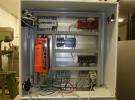Hello, I am trying get some data from my T7. I am using a twisted pair of wires as a thermal couple and I need the formula to convert the change in voltage to tempature. I used the example formula found on the website but it just recorded all zero's. this the formula I put in.
y=TCVoltsToTemp[K:c:a] which i found on this page https://labjack.com/support/software/applications/t-series/ljlogmany help would be appreciated.



.png%3Fitok=PHGBxf6M)


.jpg%3Fitok=B1YcuDFK)
.png%3Fitok=Ybt-OlgU)
Hello,
What type of Thermocouple are you connecting to your T7?
Have you taken a look at the T7 Thermocouples app note?
Additionally, just in case you are interested, we released a new beta version of LJLogM if you are interested in trying it out.
I inhereated this project from someone else and what they were using is just two wires twisted together. Do I need to use something other than the wires twisted together?
In order to apply the correct voltage to temperature calculations, you need to determine what types of metal are twisted together or determine the type thermocouple you are using. A short list of a few thermocouple types and the types of metal used can be found here.
If you can't find out what types of metal you have twisted together in order to determine the thermocouple type you are measuring, Type K thermocouples are really cheap on Amazon if you need to purchase a new one.
Hi: As Labjack support commented----a thermocouple relies on the "Seebeck Effect"---it requires a close union of different metals (wires)--for example, a Type J is Iron + closely welded to Copper/Nickel --aka (Constanton) minus--the introduction of heat-- (low to quite high)--- produces a voltage (millivolt range) that accurately follows the level of heat activity----there are literally hundreds of different themocouples useable from a few hundred C degrees to thousands ---the heat range being measured requires different thermocouples (J, K, T etc) made of different alloys, Tungsten, Rhenium, Rhodium, Platinum and so on----In my opinion you could not find a better reference of this technology and other than Omega. com----they are the go to for the world of sensors of every kind. I have used their products for 50 years--- Good Luck, Bob
I found out we are using type K thermocouple wire
I suggest you start with the tutorial:
https://labjack.com/support/software/applications/t-series/kipling/regis...